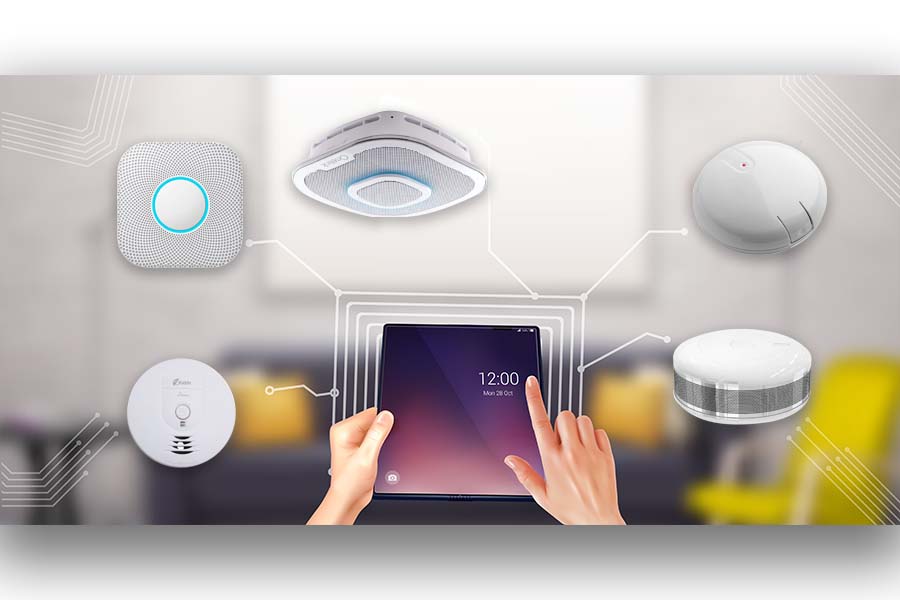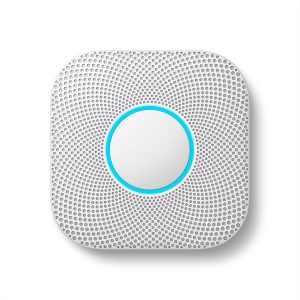If you’re at home, traditional dumb smoke alarms will surely wake you up and warn you to danger.
Unfortunately, they’re rather worthless if you’re not at home because you can’t reply to an alarm and summon help.
This problem is solved by a smart version, which notifies you when there is a problem no matter where you are. Especially the best z-wave smoke detector would help here.
How did we go about choosing the finest Z-Wave smoke detectors?
We looked at industry data and weighed device features, performance, and specifications to find the best smoke alarms.
For further help, we turned to the National Fire Protection Association and the US Consumer Product Safety Commission and expert ratings and genuine consumer feedback.
Nest Protect Smart Smoke and CO Alarm
The Split-Spectrum Sensor in Nest Protect’s design helps it distinguish between fast-burning and simmering flames.
That means it detects flames faster than other smoke alarms and notifies you sooner. So when Smoke is detected, you’ll get a faster “heads-up” signal.
It’s simple to set up the Nest Protect Smoke and Carbon Monoxide Alarm.
Furthermore, voice prompts, pulsating light codes, and smart device app integration offer warnings and alerts that make it simple to determine when an issue needs to be addressed.
All these features make it our best z-wave smoke detector.
Things We Like
- Connectivity between smart devices
- An early warning system warns you before the alarm goes off.
- Automated battery testing and monitoring
- Motion-activated night light
Things We Don't Like
- Expensive
- Google's ability to acquire data from homeowners
Kidde RF-SM-DC Wireless Interconnect Battery-Operated Smoke Alarm
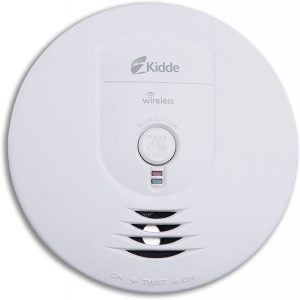
Allows for the quick and easy installation of a smoke alarm system that is interconnected without the need for messy wire or labor.
Wireless technology employs radio frequency to broadcast and receive signals about danger in the home, so when one alarm goes off, they all go off.
Installing linked alarms without rewiring is possible thanks to battery power. In addition, smart touch buttons mute obnoxious alarms fast and momentarily.
When installed in the proper areas across a home, these battery-powered z-wave smoke detectors provide comprehensive home fire and carbon monoxide protection.
Co-locating these z-wave devices, one with a photoelectric sensor for slow-burning fires and another one with an ionization sensor for blazing fires, offers redundant protection if one of the alarms is deactivated due to a false alert or if one of the units’ batteries dies.
Things We Like
- Exceptional client service
- Well-known and dependable brand
- A generous 10-year limited warranty is included.
- The wireless setup is really simple.
- It can communicate with up to 12 smoke detectors.
Things We Don't Like
- Smoldering flames are not detected.
- A single source powers it.
First Alert Onelink Safe & Sound
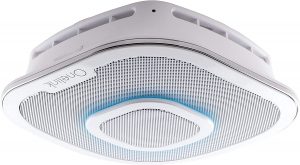
The Onelink Safe & Sound smoke/CO detector is one of the most costly z-wave smoke detectors available, but it’s not just your average smoke detector.
It not only delivers push notifications to your smartphone when its sensors are activated, but it also functions as an Amazon Alexa device that can do all of the functions of an Echo.
It also has Apple HomeKit compatibility and a strong 10-watt BMR speaker that produces high-quality audio.
It requires hardwiring, but neither that nor the price disqualifies it from winning our Editors’ Choice.
The Onelink Safe & Sound from First Alert is much more than regular smoke detectors or monoxide detectors, with a built-in Wi-Fi connection, a robust speaker, and compatibility for Amazon Alexa and Apple HomeKit.
Things We Like
- Alerts for Smoke and carbon monoxide.
- Compatible with a variety of smart home devices.
- Alexa voice service is built-in.
- Apple HomeKit is supported.
- A powerful orator.
Things We Don't Like
- Expensive.
- Hardwiring is required.
- IFTTT is not supported.
First Alert 2-in-1 Z-Wave Smoke Detector
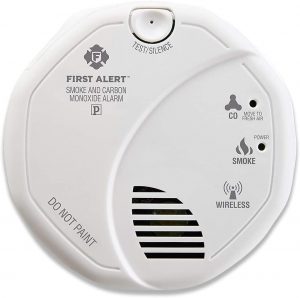
This z-wave smoke detector’s main component is built on tried-and-true technology from First Alert’s standard product range.
The photoelectric smoke sensor reduces false alarms from cooking, steam, and other everyday activities.
Both the smoke and CO sensors will activate the alarm in just the same manner, with each flashing the alarm’s appropriate LED.
Another important selling point is the Z-wave Plus compatibility. This makes it easy to add the device to your network because you can utilize the QR code on the bottom to help with the procedure.
Unfortunately, the Combo alarm merely makes use of the Basic command class, which has no special functionality defined. As a result, check to see if your Z wave controller supports these. Otherwise, you may be limited in your functionality.
There aren’t many reliable smoke alarms that support Z wave. First Alert is good, though simple, an alternative that works effectively and has the distinct advantage of being completely supported by Ring’s alarm system.
Things We Like
- Z-Wave Plus is a new product from Z-Wave.
- Support for Ring Alarms
- Photoelectric Smoke Detection
- CO Detector
- There is no wiring because it is battery-powered.
Things We Don't Like
- There is no internet access.
- A sensor with a 7-year life span
Ring Alarm Smoke and CO Listener

If you have a standard smoke and carbon monoxide detector that you don’t want to replace, this device is a fantastic option.
If you’re a Ring Alarm subscriber, you may use this device to convert your standard z-wave smoke detector into a smart detector.
If the Listener detects the sound of a typical smoke and CO detector, you’ll receive a notification via your smartphone app.
It’s reasonable to assume that people have purchased this device under the impression that it detects Smoke.
But that isn’t true. This device can supplement standard detectors and assist individuals who are deaf in receiving warnings on their phones.
It’s a wonderful addition to your Ring Alarm security system that may assist keep you safe if needed in your situation.
Things We Like
- Cost-effective
- Installation is simple.
- Good for deafeningly deafening
Things We Don't Like
- Alarms that are false
- Life of the battery
- A ring Alarm security system is required.
Fibaro Smoke Sensor
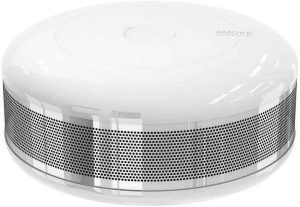
The Fibaro Smoke Sensor is a compact, attractive gadget. It really has a finer appearance than the standard smoke detector used in commercial buildings.
It is battery-powered, so there is no need to bother about power cables. In addition, it is compatible with the Z wave. Plus, which is also known as Z-Wave Gen5 and the 500 Series.
The Fibaro Smoke Sensor not only detects Smoke but also monitors temperature. Simply for monitoring and tracking reasons, the temperature can be transmitted to the home automation controller.
The temperature may also be used as an alarm trigger by the Fibaro Smoke Sensor. Any temperature reading exceeding 55°C, for example, might set off the alert.
In this approach, the Fibaro Smoke Sensor serves as both a sensor and a controller.
Things We Like
- The gadget is small and attractive.
- Both Smoke and heat are detected.
- Configurable to the max
Things We Don't Like
- Expensive
Samsung ADT Smoke Alarm

The Samsung ADT smoke alarm is an excellent SmartThings smoke alarm. You’ll get notifications if your home detects Smoke or severe temperatures.
In addition, you may utilize ADT professional monitoring services because of its connection with ADT. The First Alert SmartThings smoke detector, with the exception of a SmartThings hub, is hardware-independent.
The Samsung ADT smoke alarm, on the other hand, is hardware-independent.
Furthermore, ADT’s linked smoke alarm does not have carbon monoxide detection. As a result, you’ll have to buy a second CO sensor if you want that feature.
Fortunately, ADT sells a SmartThings carbon monoxide detector that works well and requires the ADT security starting kit. Nonetheless, ADT is a reliable home security provider, and the SmartThings smoke detector does not disappoint.
Things We Like
- ADT is a well-known brand.
- SmartThings compatible
- Compatibility with the SmartThings ADT security starting kit is excellent.
- Simple to set up and utilize
- When high temperatures or Smoke are detected, get notifications, set lights, and control other SmartThings devices.
- Integration with ADT's professional monitoring services is an option.
- Simple to set up
Things We Don't Like
- SmartThins ADT security starting kit is required; it does not connect directly to the SmartThings hub.
- A monthly charge is required for ADT professional monitoring services (optional).
- There is no CO monitoring.
Ecolink Z-Wave Plus Audio Detector
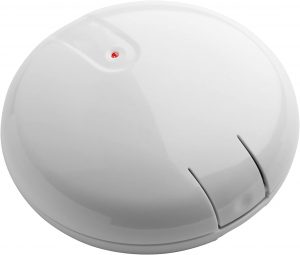
While the best z-wave smoke detectors are available from First Alert and ADT, you may choose an option that requires little to no installation.
The Ecolink Z-Wave Plus audio detector does not check for Smoke or carbon monoxide.
Instead, it scans your house for smoke alarms or carbon monoxide detectors. The Ecolink detects the sound of an alarm and sends mobile alerts.
As a result, if you don’t want to put up smoke detectors, this smoke alarm listener is an excellent alternative. It’s a cost-effective smoke and CO detector that works with SmartThings thanks to its single sensor that provides whole-home coverage.
The Ecolink audio detector also works with Vera Plus, Vera Edge, Vera Lite, HomeSeer, D-Link Staples Connect, and other smart home devices.
However, the Ecolink has one major drawback: unlike ADT and First Alert smoke detectors, it does not detect Smoke, extreme temperatures, or carbon dioxide. It instead relies on external alerts, which it monitors.
Finally, it’s a fantastic option that works nicely.
Things We Like
- Audio detector - searches your house for existing Smoke and carbon monoxide detectors.
- Wireless technology is known as Z-Wave
- Coverage for the entire house
- It does not need any retrofits
- SmartThings, Vera Plus, Vera Edge, Vera Lite, HomeSeer, D-Link Staples Connect, and Piper NV are all compatible.
- Affordable
Things We Don't Like
- Smoke, extreme heat, or carbon monoxide are not detected immediately.
What to look for in a smoke detector?
Carbon monoxide and Smoke
Your house needs to alert you about the dangers of both Smoke and carbon monoxide. Some detectors can accomplish both, so you don’t have to deploy (and manage) several devices.
Note that, as previously said, smart batteries and smart listeners do not directly detect Smoke or CO, so you’ll need to make sure your house’s real alarms enable these sorts of detection.
Detector sensitivity and accuracy
Without actually burning down your house, it isn’t easy to objectively assess how effectively a smoke/CO detector performs its primary function.
Simulating smoky circumstances, on the other hand, can offer some information about a detector’s sensitivity.
You may also take into account the broad agreement on the underlying technology of a smoke detector.
Various types of notifications
Although a loud siren is expected, verbal warnings are very useful: They can inform you not just what sort of threat has been identified but also where it is and how to respond (whether it’s opening a window or contacting 911).
Another advantage is the alarm’s color-coded LEDs. And, of course, prompt push alerts to your phone are a necessity.
Multiple users are allowed
Obviously, you’re safer if more than one person receives a push notification that the house is on fire. So look for a system that uses an invitation system to accommodate numerous users.
Interconnectivity
Some gadgets have the ability to communicate with one another, so if one alarm goes out, all of the other alarms in the house will go off as well.
If you have a large house and are concerned that you might not hear an alarm going off elsewhere, this can be a huge help.
Because we only tested single alarms in our evaluation, we didn’t test interconnectivity features, so verify the specifications.
Consider if a major smart home hub supports your smoke alarm if you want to link it with the rest of your house.
For example, the Nest Protect is clearly linked to the Nest ecosystem, but it also has Alexa, SmartThings, and HomeKit choices. It’s worth noting that we experienced mixed success with some of these hooks—and even if you do connect the alarm to your smart home hub, there’s no guarantee that it’ll work.
How Do Z-Wave Smoke and Carbon Monoxide Detectors Work?
Photoelectric sensors are used in most smoke detectors these days, which means they detect Smoke using light.
A low-light emitting diode and a light-sensing sensor are both included in this sort of detector.
The sensor detects that light when Smoke or other particles in the air reflect it and the alert sounds. Smoke detectors of this type are extremely quick to react.
Ionization sensors, which employ ions to detect Smoke in the air, are the other sort of detector. These detectors have a higher rate of false alarms than photoelectric detectors, although they are typically less expensive.
Carbon monoxide detectors are frequently included in the finest contemporary smart smoke detectors.
Carbon monoxide is a poisonous gas that is odorless and almost undetectable. CO leaks are most commonly caused by a furnace, although they may happen in any house.
This odorless gas can build up in the home if there isn’t enough ventilation, causing serious sickness, if not death.
Carbon monoxide detectors use an electrochemical sensor with electrodes in a chemical solution to monitor a shift in electrical current whenever the gas comes into contact with the electrodes.
Types of Z-Wave smoke detectors
Ionization, photoelectric, and dual sensors are the most common types of sensors found in smoke alarms. The following are the key distinctions between the three.
Photoelectric
Light is used to detect Smoke in photoelectric smoke alarms. Smoke particles floating in the air (as with a smoldering fire) disperse the light beam in the sensory chamber, triggering the alarm.
Ionization
Ionization smoke detectors detect Smoke using radiation and an ionization chamber. Ionizing radiation aids in the detection of small quantities of Smoke in the air, such as that produced by a burning fire.
When Smoke enters the sensor chamber, the ionizing radiation current is interrupted, causing the alarm to sound.
Dual sensors
Photoelectric and ionization sensors are included in dual sensors. These are thought to be the safest Smoke and fire detectors.
Because these dual-purpose sensors detect both blazing and lesser, smoldering flames, it’s doubtful that any fire-related hazard will slip past them.
Best Z-Wave Smoke Detecto – FAQs
What is the difference between a smart smoke alarm and a traditional smoke alarm?
Smart smoke and carbon monoxide detectors, like other smart home gadgets, link to your house’s Wi-Fi and, as a result, your smartphone.
To put it another way, they go above and beyond the standard smoke alarm.
Smart smoke detectors are popular for this reason, but some high-end versions incorporate other “smart” functions such as voice control via Alexa, weather updates, and more.
What is a monitor?
Monitors effectively “listen” for your smoke and carbon monoxide alarm to go off, and if they do, they send you a smartphone notice.
They’re usually put near your current smoke detectors, and they’re connected to your home Wi-Fi network.
Some plug into an electrical outlet, while others are battery-powered. They do not, however, enable you to do so.
What does a Z-wave alarm entail?
Z-Wave is a radio-wave-based wireless technology that allows smart gadgets and appliances to interact with one another.
The use of Z-Wave technology in a range of smoke and carbon monoxide alarms gives a number of intuitive advantages not seen in other detectors.
- Advanced Smoke + Carbon Monoxide Detection means you’ll be notified of these two dangers via a loud (85dB) alarm as well as a mobile device notification. This provides additional security by allowing you to maximize your peace of mind when you’re away from home. (Z-Wave is compatible with the Ring Alarm Security Kit.)
- Interconnected Alarm Feature: This feature allows you to connect numerous First Alert Z-Wave Smoke & Carbon Monoxide Sensor Alarms. Place detectors in several rooms to create a personalized security network that is tailored to your environment. When one alarm is activated, it sets off all other alarms that are connected to it. This is a fantastic feature that can improve your Smoke and CO protection.
Conclusion
The Nest Protect is the finest smart smoke detector available (view at Amazon). It has advanced sensors, the capacity to link to other smart home devices, and it can be operated remotely while providing information on light, occupancy, and even humidity.
On the other hand, the Kidde RF-SM-DC Wireless Interconnect Battery-Operated Smoke Alarm is a good choice for a more inexpensive alternative.
It may lack certain high-end features, but it nails the fundamentals.
